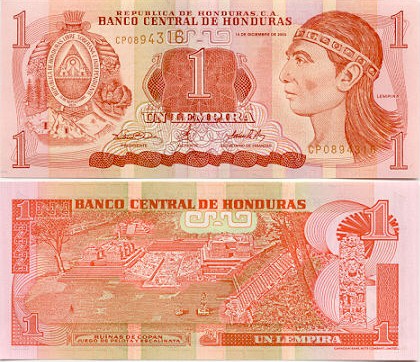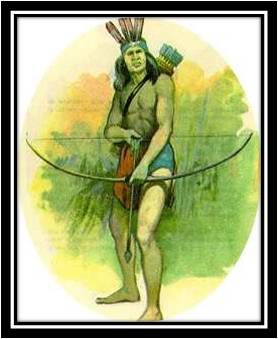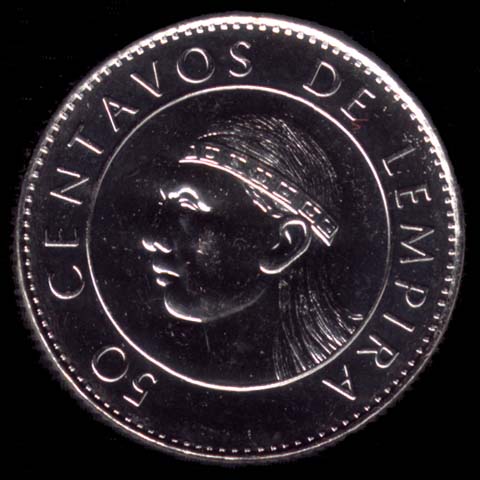Is kind of funny, so i thought this morning, well, Let´s talk about Honduran Money and the person who inspired such a strange name.
Here is the Guy!
The lempiras is the currency of Honduras. It is subdivided into 100 centavos. The lempira was named after the 16th-century cacique Lempira, a ruler of the indigenous Lenca people, who is renowned in Honduran folklore for leading the (ultimately unsuccessful) local native resistance against the Spanish conquistador forces. He is a national hero, and is honoured on both the 1 lempira note and the 20 and 50 centavos coins.
The lempira was introduced in 1931, replacing the peso at par. In the late 1980s, the exchange rate was two lempiras to the U.S. dollar (the 20 centavos coin is called a daime as it was worth the same as a U.S. dime). As of July 18th, 2011, the lempira was quoted at 18.875 HNL to 1 USD. U.S. dollars are widely accepted as currency on the Bay Islands, but the mainland mainly deals in Lempiras. Businesses in major tourist centers on the mainland will also generally accept dollars.
Here are some Honduran most common Bills!
 The Bank of Honduras and the Banco Atlantida issued the first lempira banknotes in 1932. They were in denominations of 1, 2, 5, 10 and 20 lempiras. The Central Bank of Honduras took over production of paper money in 1950, introducing 50 lempiras notes in 1951. In 1975, 100 lempiras notes were added, followed by 500 lempiras in 1995.
The Bank of Honduras and the Banco Atlantida issued the first lempira banknotes in 1932. They were in denominations of 1, 2, 5, 10 and 20 lempiras. The Central Bank of Honduras took over production of paper money in 1950, introducing 50 lempiras notes in 1951. In 1975, 100 lempiras notes were added, followed by 500 lempiras in 1995.
Now some history!! Who is this indigenous lider?
The Lenca chief, Lempira, a warrior of great renown, managed to unify more than two hundred Indian tribes that had been ancient rivals in order to offer an organized resistance against penetration by the Spanish conquerors. In the village of Etempica he announced his plans to expel the Spaniards and gave instruccions to all his allies for a general uprising when he gave the signal. On top of the great rock of Cerquín, an impenetrable fortress, he gathered all the neighboring tribes as well as abundant supplies and made trenches and fortifications. He finally gave the signal to attack by killing three unsuspecting Spaniards, who happened to be in the region.
Governor Montejo ordered Captain Alonso de Cáceres to attack the stronghold, but it was impossible to take. Montejo then gathered a large number of Indians from Guatemala and Mexico as auxiliary forces, mobilized nearly all the Spanish troops at his disposition, and ordered them to storm the rock. Yet Cerquín remained invincible. At the same time, Lempira ordered a general insurrection, Comayagua was set on fire, and the Spanish inhabitants had to flee to Gracias. Gracias was threatened by the surrounding tribes; San Pedro de Puerto Caballos and Trujillo were placed under siege and the Spaniards were hard pressed to maintain their ground.
While Montejo sought help desperately from Santiago de los Caballeros in Guatemala, San Salvador, and San Miguel and even from Spain, Alonso de Cáceres resorted to treason to get rid of Lempira. He invited the chief to a peace conference; and when Lempira reaffirmed his desire to continue the fight, a hidden marksman shot him in the forehead. Lempira fell from the highcliffs; and with his death, his 30,000 warriors either fled or surrendered.
Another Perspective
LEMPIRA (lem-pee'-rah), Central American cacique, born in the latter part of the 15th century; died in 1537. He was the king of Coquin, afterward called Gracias a Dios, and his name signifies "Lord of the Mountains." At the beginning of the conquest the Spaniards were unmolested, but later the Indians revolted, on account of their cruelties, under the leadership of this chief. He had long been a terror to the settlers and a warrior of note among his own countrymen, and was said to bear a charmed life. He had been attacked in his stronghold of Cerquin, close to Gracias a Dios, by Alvarado with a strong party of troops and 2,000 friendly natives; but the assault was unsuccessful.
Lempira now proposed to annihilate the invaders, and, gathering a large army, opened hostilities at once. Montejo, governor of Yucatan and Honduras, sent a force to quell the movement, whereupon Lempira retired to his stronghold and siege was laid to the place; but, although assistance was summoned from Comayagua and San Pedro del Puerto de Caballos, the Indians made good their defence. For six months the Spaniards beleaguered the fortress, and, seeing no prospect of taking it, had recourse to a stratagem. A horseman was ordered to approach within arquebus-shot of the rock and summon Lempira to a colloquy, under pretence of opening negotiations for peace, while a foot soldier who accompanied him, screened from view by the mounted man, shot the unsuspecting chieftain as he appeared on the cliff. His lifeless body rolled over the rock, and his followers, panic-stricken, made no further resistance.
In my opinion this is a very romantic version of this men, but since we are in the school we celebrate the Lempiras national day, in 20 of july. I remember it was a cool day, we went to the school on disguise, actually as indigeous as well. My mom used to prepare my custom in advance and she always made this nice tiara full of feathers!!
We also learned some folklore and common dances.
So here it is the Lempira Nationan Anthem!
So, as you can see, he is the reason of our National Currency and also he became one of the heroes of the Honduran Culture.
Hope you like it and find this post useful.





No hay comentarios:
Publicar un comentario